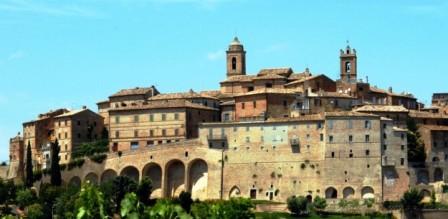Montefiore dell’Aso
City of Montefiore dell’Aso
Republic Square, 2 – 0734/939019
FOR INFORMATION ON GUIDED TOURS:
Cultural Association Agheiro:
0734/938743 Agheiro@gmail.com
The territory of Montefiore dell’Aso was inhabited since prehistoric times, but the most documented is the Piceno civilization between the ninth and fourth centuries BC
With the conquest by Rome, Montefiore became a centuriation Ager Cuprensis, or the nearby Roman Cupra. In the early centuries of Christianity, probably between the third and fifth centuries, Montefiore became the seat of a Parish. Following invazioni barbarian, for defensive reasons, they began to form of fortified villages, the “Castrum”.
In a document of 1178 it comes to Montefiore and Aspromonte which, uniting in a single town, at the end of the twelfth century, gave birth to the Free City of Montefiore. Since 1387 the town was incorporated into the orbit of Fermo. At the end of the fifteenth century, with the fall of the free towns, also Montefiore fell under the dominion of the Papal States. During the seventeenth century, the political life of the town was run by a closed class, made up of nobles and large landowners. The situation did not change with the unification of Italy and lasted until World War II.
Museums of San Francisco
The construction of the convent of San Francesco, in the west of the city center of Montefiore dell’Aso, dates back to the thirteenth century.
Some testimonies attest to the beginning of the factory: a bull of Pope Innocent IV, dated 1247, urges the faithful to the generosity for the completion of the church and the buildings of the Friars Minor; in the same church, a plaque brings the blessing of the foundation stone took place in 1264 at the hands of Pope Urban IV. Built according to the canons of construction proportional Franciscan, it is mentioned and described in the text Genealogy century Ilario Altobelli. The author presents the diagram of the Convent, the Church and the two cloisters, one in the courtyard meditative purposes, the other for the use of Hortus conclusus, located in Piazza San Francesco. In 1653 he suffered the suppression Innocent. Returned by purchase order in 1682, it underwent restoration.
of the factory: a bull of Pope Innocent IV, dated 1247, urges the faithful to the generosity for the completion of the church and the buildings of the Friars Minor; in the same church, a plaque brings the blessing of the foundation stone took place in 1264 at the hands of Pope Urban IV. Built according to the canons of construction proportional Franciscan, it is mentioned and described in the text Genealogy century Ilario Altobelli. The author presents the diagram of the Convent, the Church and the two cloisters, one in the courtyard meditative purposes, the other for the use of Hortus conclusus, located in Piazza San Francesco. In 1653 he suffered the suppression Innocent. Returned by purchase order in 1682, it underwent restoration.
There was a new period of prosperity witnessed by a note of 1818, in which he documents the excellent state.
Sala Carlo Crivelli
The room is dedicated to the Venetian Carlo Crivelli who in 1468 moved from the Dalmatian coast in the Marche, where he remained until his death, working in Fermo, Ascoli Piceno and Camerino. In the Hall of the first floor is exposed the triptych that the artist created in the early ’70s of four for the Church of the Friars Minor Conventual of Montefiore dell’Aso. The work, the remains of an original altarpiece dismantled and partially sold on the antiques market around the middle of the nineteenth century, bears witness to the role of patronage in the execution, for the presence of three tables dedicated to the Franciscan friars, to which must add the St. Francis today in Brussels.
Documentation Centre Scenic Giancarlo Basili
The extensive collection, divided into different rooms of the complex, including stage sets, photographic documentation, graphic sketches, critical texts and video material regarding films: Nirvana Gabrile Salvatores (Italy, 1996), Palombella Rossa by Nanni Moretti (Italy, 1989) , The Son’s Room by Nanni Moretti (Italy, 2000), Italian Night by Carlo Mazzacurati (Italy, 1987), Love Carlo Mazzacurati (Italy, 2004), The Caiman by Nanni Moretti (Italy, 2006), Tomorrow happen by Daniele Luchetti (Italy, 1988), Little Teachers by Daniele Luchetti (Italy, 1998), The Man by Daniele Luchetti (Italy, 1990), I’m not scared by Gabriele Salvatores (Italy 2003), When You’re Born You Can No Longer hide by Marco Tullio Giordana (Italy 2005), PAZ Renato De Maria (Italy 2002), The Way We Laughed by Gianni Amelio (Italy 1998), The House Keys by Gianni Amelio (Italy 2004), Light of My Eyes by Giuseppe Piccioni ( Italy 2001), comes the blizzard Daniele Luchetti (Italy 1993).
Museum Adolfo De Carolis
The collection Adolfo De Carolis, exhibited in the hall since the second half of the twentieth century in Sala De Carolis, collects about 500 works by the famous artist born in Montefiore dell’Aso, the set includes drawings, sketches and woodcuts acquired by the City. The collection includes the 69 oil sketches for the realization of the frescoes of the Hall of Four in the Palazzo del Podesta Bologna donated by Egidi Francesco in 1959 and more than 100 woodcuts received at Montefiore in 1974 thanks to the donation of the family De Carolis. In these early works, mostly exposed in the Sala De Carolis, it has added an important corpus of about 250 drawings, studies and sketches donated by the family of Carlo De Carolis in 2006 and a few pieces of furniture Studiolo Bologna Borgo San Pietro n 39 donated in 2005 by Giovanni De Carolis.
Museum of Rural Life
The collection of the Museum of Rural Life dates back to 1984. How many of these civic collections, is an opera composed by private donations be initiated by the school for educational purposes. The exhibition was first staged in the school near the Collegiate Church of Saint Lucia, later moved into two rooms of the Convent of St. Francis, then temporarily recovered. The current theatrical setting, located on the first floor in the southern corridor of the cloister, exhibited in four sections: the yard, the house, the job, the field some of the approximately 400 objects and tools related to home life and work in the fields, all from families of the territory of Montefiore dell’Aso.
Collection Domenico Cantatore
The collection Domenico Cantatore was donated to the City of Montefiore dell’Aso artist himself with Council Resolution No. 139 of 22 August 1989. The set consists of 114 graphic works between aquatints, etchings, lithographs of cork and paper. The collection was displayed in the hall of the first floor, among them are the famous odalisques, portraits of men of the South, roosters and landscapes.
Curiosity …
The floral display of Montefiore dell’Aso is a magical time where the sacred, faith, art and nature come together nicely drawing paintings in the ground as in the heart.
Every year, during the holy festival of Corpus Christi, the ‘”Flower Festival”, an immense floral carpet stretching articulated in various frameworks for about 2000 square meters., It covers the entire path of the solemn procession.




